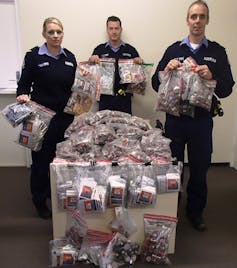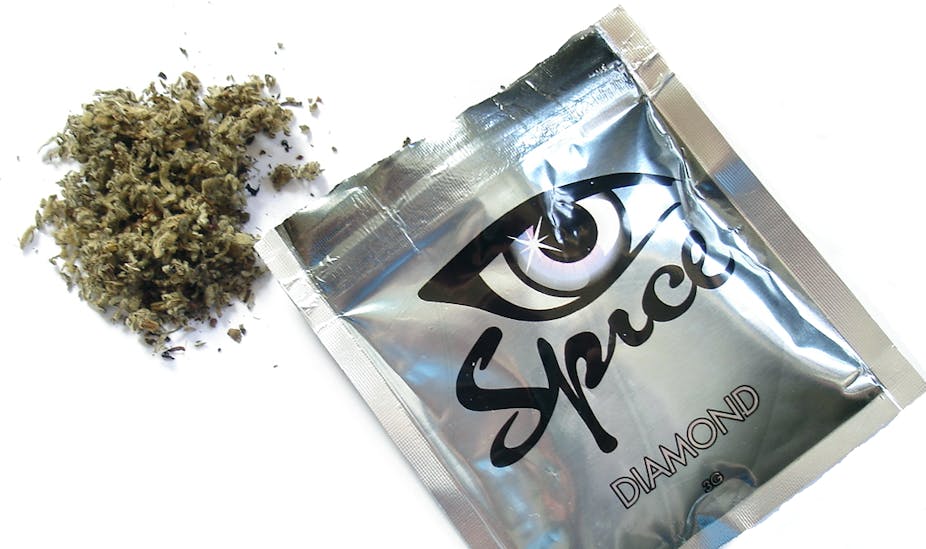For decades, cannabis has remained the most popular illicit drug among Australians. The strong demand among cannabis and other drug users for methods to evade detection and legal trouble has made online products such as “drug-free urine” popular.
More recently, this demand has fuelled the influx of a new category of borderline illicit substance – synthetic drugs.
Designed to mimic the effects of cannabis, synthetic cannabinoid products are not “herbal highs”, as is often described on their packaging and in the marketing on various websites.
To the contrary, the products contain synthesised chemical compounds that are sprayed on to green herbs similar in appearance to cannabis. Quite often these products contain ingredients that are not stated on their packaging.
Fuelling the demand
So why are so many Australians placing their trust in illegitimate manufacturers to obtain these products? One answer is that the products do not contain delta-9-tetrahydrocannabinol (THC), the active ingredient in cannabis. So they will not show up in most drug tests administered by employers.
The products are also readily available via tobacconists, sex shops and various websites. This enhances their appeal to those unable to source cannabis easily, or who do not want to break the law.
Drug using offenders don’t trust synthetics
As popular as these products are, one segment of the population has little trust towards the new phenomenon of synthetics that has exploded globally in recent years: that is, regular drug-using offenders.
The Australian Institute of Criminology (AIC) interviewed almost 900 offenders through the Drug Use Monitoring in Australia (DUMA) program about their experience with synthetic cannabis.
The report, released by the National Cannabis Prevention and Information Centre (NCPIC) found the majority of offenders did not trust synthetic cannabis.
One thing is important to emphasise: many offenders in the DUMA study are entrenched in the “drug scene”, with almost half the sample using cannabis and more than one in five using amphetamines. That the majority of DUMA detainees simply will not go near synthetic cannabis says a lot about their perception of the drug.
This lack of trust is not surprising given that among the 4% who did use synthetic cannabis, the most common reported negative side effects were dizziness, nausea, vomiting, paranoia, panic attacks and headaches.
Other reported symptoms included heart palpitations requiring emergency care, chest pains and difficulty breathing. Not exactly a fun night out.
While research shows that excessive cannabis use has its own concerning side effects – links to psychosis, enhancing the onset of mental illness, short-term memory impairment, lower cognitive function – regular drug-using offenders would rather risk these side effects than gamble with the potential unpredictable effects produced by synthetic cannabinoids.
Misleading marketing
But there are others less entrenched in the drug world who are more likely to trust the marketing ploys of sneaky manufacturers.
Promotional statements like “legal weed” or “natural herbal blends” can be found plastered over colourful websites or on the packaging of products.

These statements are misleading Australians into believing they are purchasing safe and legal products. In reality, many synthetic cannabis products are neither, and consumers who trust the marketing messages could find themselves with a criminal record and some unpleasant or concerning symptoms.
Further, in some jurisdictions, synthetic cannabis users are not diverted from the criminal justice system. For example, in Queensland there are no provisions for participation in the Drug Diversion Program for people found in possession of synthetic cannabis.
If this drug continues to be popular among Australians, there may be an increased number of drug users who come into contact with the criminal justice system and are not diverted into treatment.
Drug driving
A recent study by the AIC and NCPIC found that one-third of a sample of cannabis using offenders drove under the influence of cannabis. Of concern is that 70% of these users believed their driving skills were not affected at all by cannabis use.
With synthetic cannabis use becoming more prevalent in recent years, the dangers of use of this drug combined with driving could be detrimental.
Manufacturers are one step ahead of the game
In 2011 state/territory legislation was introduced that banned specific synthetic cannabinoid compounds on the market. This largely failed to prevent the availability of synthetic cannabis products.
Queensland Police for example found that within a few weeks, manufacturers would replace recently banned compounds with new compounds.
In 2012 the Therapeutic Goods Administration (TGA) aimed to counteract this issue by introducing a blanket ban on any type of synthetic cannabinoid that produces the same pharmacological effect as cannabis.
However, according to the United Nations Office on Drugs and Crime, a major challenge in the detection of such products is that drug tests must continually adapt to capture newly manufactured compounds. Given the lack of reference material for synthetic cannabinoids, the identification of new compounds can be particularly time-consuming and costly.
Policy options
So what are other countries doing to address this global problem?
New Zealand will soon introduce what has been described as “revolutionary” legislation that places the onus of responsibility on manufacturers of synthetic cannabis. Under the new Psychoactive Substances Bill, manufacturers will be able to sell their products legally, but only if extensive clinical safety trials prove they are safe for human consumption.
The United States adopted a different approach by introducing the Synthetic Drug Prevention Act in 2012, which included a federal ban on 15 compounds of synthetic cannabinoids, among other synthetics. However, media reports suggest that new compounds not covered by the legislation were released quite soon after it was introduced.
It is difficult to determine the best policy option for Australia. Organisations such as the Alcohol and Other Drugs Council of Australia have identified a need for further investigation into evidence-based methods for the effective reduction in harm associated with the sale and consumption of synthetic cannabinoids.
In the meantime, it is important to raise awareness among young people over the illegality of the drug, and more importantly, the concerning and unpredictable side effects resulting from its use.

